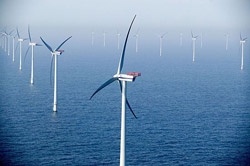 Wind Power Facts
Wind Power Facts
- As long as the Sun shines on the Earth, wind power will exist. Since the Sun is expected to shine for anther 4.5 billion years, wind power is considered a renewable power source.
- The first recorded use of wind energy can be dated back to 5000 BC, when sail boats were propelled across the river Nile. In 200 BC, the Chinese and Middle Eastern people implemented wind energy to grind grain and pump water from the well.
- The first windmills were used to grind grain in Iran, then known as Persia.
- In ancient Persia (now known as Iran), wind mills were used to grind grains.Holland has historically been the leader in windmill technology.American colonists used wind mills to move water, grind grain and cut wood.
- Windmills were a significant source of power in rural America in the 1920’s.
- California is the leading wind power producer in the United States.
- Germany is the largest wind power producer in the world. Spain is second.
- There are two types of windmills - Horizontal windmills look like what you’ve seen on television or in books, i.e., the traditional structure with a wheel of blades perpendicular to the ground and spinning. Vertical windmills look like upside down eggbeaters.
- Wind power plants are typically owned by private companies, which sell the power to traditional utility companies.
- The United States gets roughly 17 billion kilowatts of electricity each year from wind power.
- This yearly wind power production is enough to provide all the power needs of the City of Chicago.
- On a commercial level, wind power electricity is produce in 30 states.
- Modern wind turbines found in Hawaii, stand as tall as 20 floors and have a giant rotor with a size of a football field.
- To defer utility costs, individuals in every state set up min-wind power systems for their homes. The exact percentage of people that do this versus total homes is unknown.
- The U.S. ranks third in the world as a wind power producer.
Sources:
- Dr. David Suzuki. http://www.canwea.ca/images/uploads/File/Resources/SuzukiArticle.pdf
